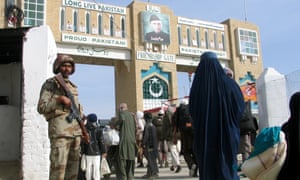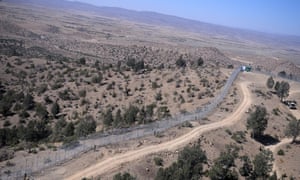Patrick Wintour
 Pakistan is building a fence along its border with Afghanistan, and it wants Donald Trump to pay for it – or at least some of it.
Pakistan is building a fence along its border with Afghanistan, and it wants Donald Trump to pay for it – or at least some of it.
The 1,800-mile barrier being constructed will help end “the prolonged agony” of the Afghan war and reduce terrorism inside Pakistan, said Nasir Khan Janjua, the national security adviser to Shahid Khaqan Abbasi, the prime minister.
Janjua said that Pakistan would like the US president to pay for the barrier – or at least the Afghan side – arguing that the $532m (£378m) price tag will be a lot cheaper than the $45bn annual estimated cost of the Afghan war.
At a briefing in Miranshah, the main town in North Waziristan – one of the semi-autonomous Federally Administered Tribal Areas – Pakistani officials laid out a timetable for construction of the 10ft wire fence running the length of the porous border with Afganistan.
In a bunker at the headquarters of the army’s 7th Infantry Division, Col Wasi Uddin said 11,136 border posts and 443 forts are being installed on the Pakistani side – seven times more than on the Afghan side.
Uddin said Pakistan planned to complete the fence by 2019, apart from a section in the extreme north of the country. The border will be fitted with underground movement sensors and a network of CCTV cameras, Uddin said.
“We will know exactly who is entering and or exiting at every crossing point,” he said.
The plan is part of an effort to show that Pakistan has a plan to ease the Afghan crisis – rather than simply rejecting Trump’s preferred outcome of a military defeat of the Afghan Taliban.
“The Muslim world is in turmoil and what has been bothering it most has been the instability of Afghanistan for the last 16 years,” Janjua said.
Janjua, a retired three-star army general, said that Pakistan is still willing to cooperate on intelligence with the Americans.
Relations between Islamabad and Washington were thrown into disarray at the start of the year, when the White House abruptly announced it was suspending some security assistance to Pakistan, arguing that its military and intelligence services were giving sanctuary to the Afghan Taliban and the Haqqani network.
Trump’s actions have put US-Pakistan relations into their most fragile state since the US discovered Osama bin Laden living under the noses of Pakistan intelligence in 2013.
Anti-Americanism is rife across the country and, in an election year, is being exploited by all parties.
Trump could take further measures, and has endorsed further unilateral US drone strikes inside Pakistan territory – something Janjua said undermined Pakistan sovereignty. The US is pushing to have Pakistan included on the Financial Action Task Force’s “grey list” of countries failing to crack down on terrorism financing.
Janjua said Pakistan wanted to cooperate with the US. “The Americans have blamed us, and said we are responsible for safe havens but when we say ‘lets work together to find the safe havens, and isolate them’, there is no answer.”
For more than a decade, the CIA has accused Pakistan’s Inter Service Intelligence of playing a double game in which it pledges to destroy the Afghan Taliban, but protects its fighters, which it views as a useful proxy to destablise the Kabul government.
A map of the route of the barrier
The issue has as much to do with geo-politics as counter terrorism. Pakistan military regard the country’s chief strategic threat as coming from an Indian-backed government in Kabul completing a hostile encirclement of Pakistan.
As a result, Pakistan’s powerful intelligence service has always been more willing to chase down terrorists representing an internal threat to Pakistan – al-Qaida, the Tehrik-e-Taliban Pakistan (TTP) and more recently Islamic State – but have been more tolerant of the Afghan Taliban and the Haqqani network. Politicians – such as Nawaz Sharif, the ousted prime minister – who challenge the military orthodoxy or the generals’ near autonomy in foreign policy, find there are career consequences.
Major general Asif Ghafoor, the Pakistani military spokeman, said Trump’s Afghan strategy – retaining more 10,000 US troops indefinitely, modernising the Afghan air force by providing US equipment, and retraining Afghan security forces – is essentially the same failed recipe that has been tried for 16 years.
Pakistan hopes to see the start of independently brokered peace talks with the Taliban.
Many in the Pakistani elite – both civilian and military – believe that the west has ignored the sacrifices made by the country during a decade of interconnected conflicts with separatist insurgents, religious extremist politics, criminal gangs and jihadi terrorists.
“Those who fight us, blame us. Those who side with us, blame us. We are made a scapegoat and we are a poor country – so it is easy to try to blame us,” said Janjua.
In response, Islamabad has stepped up its efforts sell its own narrative, taking a steady stream of reporters, analysts and politicians by helicopter to Miranshah – once a hotbed of homegrown and foreign fighters.
This was the setting for a bitter two-year war launched by the Pakistan army after militants attacked Karachi airport in 2014. Much of the town was obliterated in the fighting.
 FacebookTwitterPinterest Pakistani soldiers patrol the newly fenced border with Afghan’s Paktika province. Photograph: Aamir Qureshi/AFP/Getty Images
FacebookTwitterPinterest Pakistani soldiers patrol the newly fenced border with Afghan’s Paktika province. Photograph: Aamir Qureshi/AFP/Getty Images
In a surreal attempt to show how the extremists operated, the army has built a Jihadi museum, including a replica warren of underground tunnels, an execution room, and a room for the preparation of suicide bombers. Two goats are tethered in the courtyard to lend reality.
The army takes visitors on a coach tour of the town to see the “new normalcy” – a sports stadium, park and bazaar being built along with health centres.
These are unprecedented public investments in a long neglected area. But the town is eerily empty, and its inhabitants forced back from the road by soldiers. Others have been sent to de-radicalisation centres.
Ghafoor said that by the end of March, Pakistan wants to start “a dignified return” of as many as 2.5 million Afghan refugees, some of whom have been in the country for decades. Humanitarian agencies say Afghanistan could not cope with an influx of repatriated citizens.
In a further sign of a tougher strategy, provincial governments are trying to bring religious seminaries – often criticised as a conyeyor belt to religious extremism –under the control of provincial education departments.
On Wednesday, authorities also banned two charities linked to Hafiz Saeed, the radical Islamist cleric who the US says was behind the 2008 Mumbai terror attacks which killed 166.
Plans have been laid to install 1,400 CCTVs across Quetta, the garrison capital in Balochistan, and allegedly home to many in the Afghan Taliban leadership.
At least three serious terrorist attacks have hit the city in the past few months.
Parked outside his office, Balochistan’s chief minister Abdul Quddus Bizenjo’s car is riddled with bullet holes.
Quddus complains that Pakistan is misunderstood, and the terrorist threat is more complex than a Trump tweet could ever allow.
“We have sacrificed more than 70,000 lives here and in our province suffered billions in damages, far more than in America. To say we are harbouring terrorists is discouraging and insulting.”
He added: “The leadership of the insurgents are not sitting here in Quetta or in Pakistan. They are based and funded from abroad, mainly by India. If America understood, it would increase aid – not cut it”.

No comments:
Post a Comment